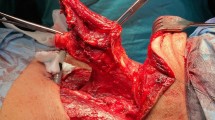Abstract
During the last 14 years, pharyngogastric anastomosis following pharyngolaryngoesophagectomy was performed in 157 patients, among whom 67 had carcinoma of the hypopharynx, 7 had carcinoma of the cervical esophagus, and 83 had carcinoma of the larynx involving the hypopharynx. The operative procedure was that described previously by Ong in 1960, and modified in 1971. The overall hospital mortality was 31%, which in the last 2 years of the study had fallen to 18%. It was found that the mortality was higher in patients with poor cardiopulmonary status and in patients whose tumors had extended into the vallecula, thus requiring resection of the posterior third of the tongue. Previous failed radiotherapy increased the risk of leakage of the anastomosis. The immediate results of the operation can be improved if the surgeon ensures that a healthy stomach is prepared, a secure anastomosis is performed, and the vulnerable blood vessels are protected. Postoperative function in terms of swallowing ability was good, but rehabilitation of speech was poor. The 5-year survival rate was 17.8%. The longest surviving patient is still alive 10 years after the original operation. The most common cause of long-term failure was the development of metastatic disease. Improvement in survival results may require the use of adjuvant therapy to operative treatment.
Résumé
Nous avons, au cours des 14 dernières années, réalisé une pharyngo-laryngo-oesophagectomie avec anastomose pharyngo-gastrique chez 157 malades; 67 cancers de l'hypopharynx, 7 cancers de l'oesophage cervical et 83 cancers du larynx envahissant l'hypopharynx. La technique opératoire utilisée est celle qui a été décrite par ONG en 1960 et modifiée en 1971. La mortalité hospitaliére globale a été de 31%; pour les deux dernières années, elle a été réduite à 18%. La mortalité est plus élevée chez les malades dont l'état cardiopulmonaire est précaire et dans les cas où la tumeur, étendue jusqu'à la base de la langue, exigeait la résection du 1/3 postérieur de celle-ci. La radiothérapie préopératoire augmente le risque de lachage des anastomoses. Pour améliorer les résultats postopératoires précoces, il faut que l'estomac soit sain et bien préparé, que l'anastomose soit réalisée dans des conditions parfaites, que les vaisseaux vulnérables soient protégés. La récupération fonctionnelle est bonne pour la déglutition, mais pauvre pour la parole. La survie à 5 ans est de 17.8%. Notre plus longue survie est de 10 années après l'opération initiale. Les métastases sont la cause la plus fréquente d'échecs à long terme. Pour améliorer la survie, il faudra peut-Être compléter la chirurgie par des thérapeutiques adjuvantes.
Similar content being viewed by others
References
Ong, G.B., Lee, T.C.: Pharyngogastric anastomosis after esophago-pharyngectomy for carcinoma of the hypopharynx and cervical esophagus. Br. J. Surg.48:193, 1960
Le Quesne, L.P., D. Ranger: Pharyngolaryngectomy with immediate pharyngogastric anastomosis. Br. J. Surg.53:105, 1966
Balasegaram, M.: Pharyngo-gastric reconstruction for carcinoma of the hypopharynx. Aust. N.Z.J. Surg.37:242, 1968
Harrison, D.F.N.: Surgical management of cancer of the hypopharynx and cervical esophagus. Br. J. Surg.56:95, 1969
Leonard, J.R., Maran, G.D.A.: Reconstruction of the cervical esophagus via gastric anastomosis. Laryngoscope80:849, 1970
Stell, P.M.: Esophageal replacement by transposed stomach. Arch. Otolaryngol.91:166, 1970
Millar, H.: The surgical treatment of cervical esophageal and laryngopharyngeal dysphagia. Aust. N.Z.J. Surg.42:368, 1973
Kakegawa, T., Tsuzuki, T., Sasaki, T.: Primary pharyngogastrostomy for carcinoma of the esophagus situated in the cervicothoracic segment. Surgery73:226, 1973
Akiyama, H., Hiyama, M., Miyazono, H.: Total esophageal reconstruction after extraction of the esophagus. Ann. Surg.182:547, 1975
Silver, C.E.: Reconstruction after pharyngolaryngectomy-esophagectomy. Am. J. Surg.132:428, 1976
Cordiano, C., Fracastoro, G., Mosciaro, O., Mozzo, W.: Esophagectomy and esophageal replacement by gastric pull-through procedure. Int. Surg.64:17, 1979
TNM Classification of Malignant Tumours, 2nd edition, International Union Against Cancer, 1974, p.23
Ong, G.B.: Resection and reconstruction of the esophagus. Curr. Probl. Surg. September, 1971
Lam, K.H., Lim, S.T.K., Wong, J., Ong, G.B.: Chylothorax following resection of the esophagus. Br. J. Surg.66:105, 1979
Lam, K.H., Wong, J., Lim, S.T.K., Ong, G.B.: Alcohol tolerance and gastric emptying after replacement of the esophagus with the stomach. Aust. N.Z.J. Surg.50:542, 1980
Leonard, J.R., Holt, G.P.: Reconstruction of the hypopharynx and cervical esophagus. Otolaryngol. Clin. North Am.5:435, 1972
Jacobsson, F.: Carcinoma of the hypopharynx-a clinical study of 322 cases, treated at Radiumhemmet, from 1939 to 1947. Acta Radiol.35:1, 1951
Staley, C.J.: A muscle cover for the carotid artery after radical neck dissection. Am. J. Surg.102:815, 1961
Author information
Authors and Affiliations
Rights and permissions
About this article
Cite this article
Lam, K.H., Wong, J., Lim, S.T.K. et al. Pharyngogastric anastomosis following pharyngolaryngoesophagectomy. Analysis of 157 cases. World J. Surg. 5, 509–516 (1981). https://doi.org/10.1007/BF01655003
Issue Date:
DOI: https://doi.org/10.1007/BF01655003




